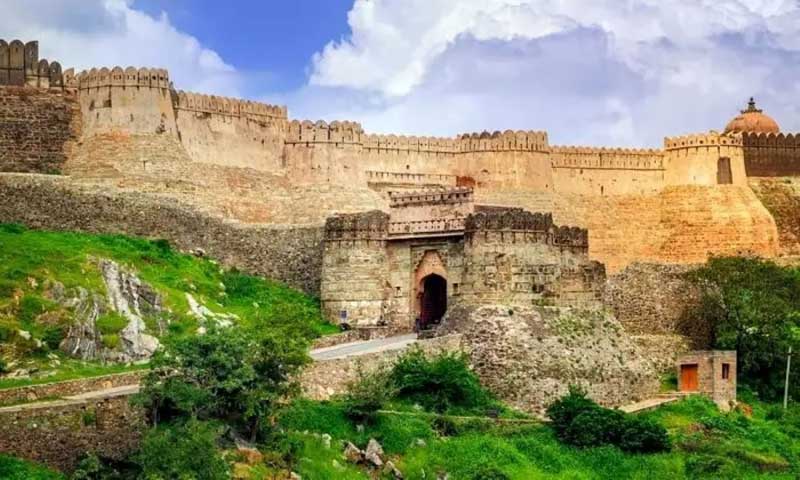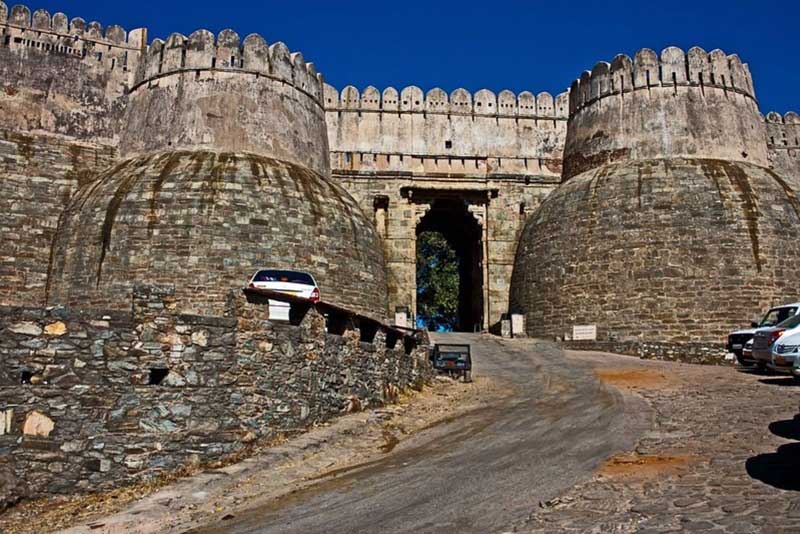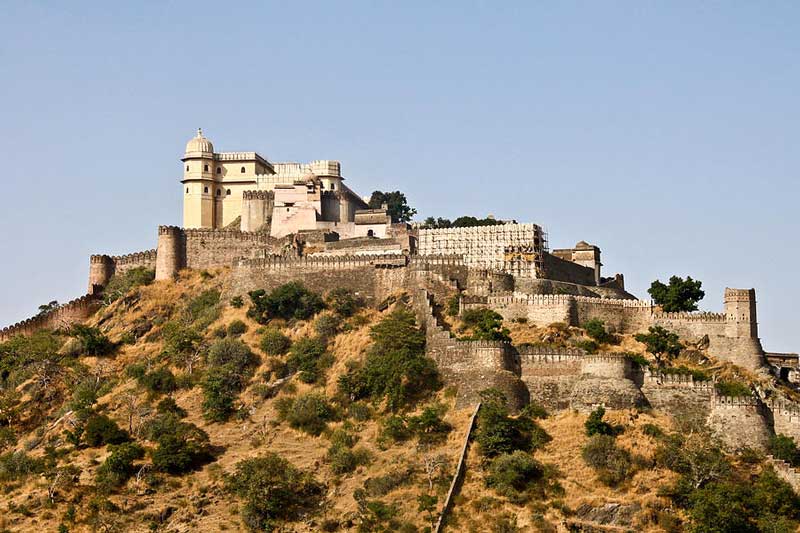
Cradled in the Aravalli Ranges and located 84 km north of Udaipur in the wilderness, the Kumbhalgarh Fort is the second-largest and the most important citadel after Chittorgarh Fort in the Mewar region in the south-central part of Rajasthan. The 3600 feet (1097 m) tall mighty fort, also known as the Great Wall of India, has the second largest wall (38 km) after the Great Wall of China that surrounds the area of Udaipur.
Considered among the largest fort complexes in the world, the fort separated Mewar and Marwar regions and contains several Hindu and Jain temples, indicating the religious tolerance of the rulers. The strongly fortified massive fort was built by Rana Kumbha of the Sisodia Rajput clan in the 15th century, between 1443 and 1458 AD, under the direction of Mandan, the famous architect of the era, who documented his style of work in his text, Rajvallabha.

The Kumbhalgarh Fort was constructed on the site of an ancient castle, known as Matsyaendra Durg, attributed to Samprati, a Jaina prince of the Maurya of the second century BC. Later, Rana Lakha, belonging to the Sisodia lineage of Mewar, won the entire area, along with the plains of Godwar, from the Chauhan Rajputs of Nadol, ruling the Marwar area in the 14th century. Named after the Rana Kumbha, famous for his illustrious military career against various sultanates, the Kumbhalgarh fort was strategically designed on a hilltop to provide necessary protection against the attack of any enemy force, as well as a place of refuge for the rulers of Mewar, in case of an imminent emergency, since the fort was impregnable to direct assault.

Built on a hilltop 3600 feet (1100 m) above sea level on the westerly range of the Aravalli Hills, Kumbhalgarh has seven fortified gateways. The first entry gate of the fort, known as the Aaret Pol, is located in the south and the Hulla Pol is located on the downward slope from the entrance. The Badshahi Bavdi, a stepped tank, located just after the Hulla Pol, was built after the invasion of Shahbaz Khan in 1578, the general of Mughal emperor Akbar, to provide water to the troops.
The Hanuman Pol, located half a km away from Hulla Pol, is a two storey gate with octagonal bastions, named after the stone image of Hanuman located in front of the gate, procured by Maharana Kumbha from Madhavpur. While the Ram Pol, located in the north, serves as the main entrance of the fort, there is another entrance towards the east, called Vijay Pol. Apart from the above, the fort complex can also be accessed through the Bhairon Pol, Nimboo Pol, Chaugan Pol, Paghara Pol and Ganesha Pol.

The Kumbhalgarh Fort contains numerous temples, both Hindu and Jain temples, signifying the religious tolerance of the rulers. Among the Hindu temples, the Ganesha Temple, situated on the left of the Ram Pol and built by Maharana Kumbha, contains the image of the Hindu deity Lord Ganesha, standing on a high platform entered through a flight of steps from the south. Built during 1458 AD, Neel Kanth Mahadeva temple, located on the eastern side of the fort, is accessible through a series of steps to a rectangular enclosure, supported by 24 huge pillars.
The temple contains a 5 feet tall idol of Lord Shiva with 12 hands, made of black stone. Another important Hindu temple in the complex is the Mataji Temple, also known as the Kheda Devi Temple, located on the southern side of Neel Kanth Temple.

Among the Jain temples, the Parsvanath Temple, housing a 3 feet tall statue of Jaina Tirthankara Parsvanath, was built by Nar Singh Pokhad in 1513. Apart from that, the Kumbhalgarh Fort complex contains many more Jain temples, including four temples in the Golera group of temples and another two temples near the Vijay Pol.

There are several palaces in the fort complex, constructed by different rulers in different ages, which includes the Rana Kumbha Palace, built in Rajput architectural style. Located close to the Pagda Pol, the palace is a two storey building consisting of two rooms, a corridor and an open space in the front, along with a beautiful blue durbar hall. It also has a corridor separating the mardana or men's wing from the zanana or women's wing. Some of the rooms in the zenana mahal have an attractively painted frieze with elephants, crocodiles and camels. However, the most interesting feature of the palace is its toilets, which have a ventilation system that allowed fresh air, while the toilet was in use. The palace also has a circular Ganesha Temple at the corner of the zenana courtyard of the palace.

Constructed by Rana Fateh Singh and located at the top of the Kumbhalgarh Fort, Badal Mahal, famously known as the Palace of Clouds, is a two storey building, divided into two interconnected sections, called the mardana mahal and the zanana mahal. The rooms of the palace are painted with pastel coloured murals, mainly with turquoise, green and white colour schemes. The zanana mahal is adorned with stone screens with lattice work, from where the women in the palace used to watch the proceedings of the court and other important events. The palace is facilitated by a series of duct pipes which allows cool air to infiltrate into the rooms, providing extra relief during the long summer days. There is another building, situated near the Paghara Pol, known as Jhalia ka Malia, which was the palace of Queen Jhali, constructed by using rubble stone. It is believed that Rana Pratap Singh was born in the palace.

The Kumbhalgarh Fort has witnessed several historic events of Mewar. During the siege of Chittorgarh Fort in 1535, Panna Dhai, the nursemaid to Prince Uday sigh, took the risk of her life to smuggle and save the life of the infant prince from Chittorgarh to Kumbhalgarh. Later, Uday Singh succeeded to the throne and founded the city of Udaipur. The fort was attacked by Ahmed Shah I of Gujarat in 1457 and by Sultan Mahmud, Sultan of the Malwa Sultanate in 1458-1459. But both of them found the fort too strong to conquer. Subsequently, in October 1577, Shahbaz Khan, one of the generals of Mughal emperor Akbar, invaded the Kumbhalgarh Fort and after a siege of 6 months, he captured it in April 1577, only to be recaptured by Rana Pratap Singh recaptured in 1578.

Enlisted in UNESCO World Heritage Site under the group Hill Forts of Rajasthan, the Kumbhalgarh Fort is an attractive tourist spot and to the delight of the visitors, the Rajasthan Tourism Department organises a three-day annual festival in the fort, when sound and light shows are arranged in the background of the massive fort. In addition, various concerts and dance events are also arranged to commemorate the function.